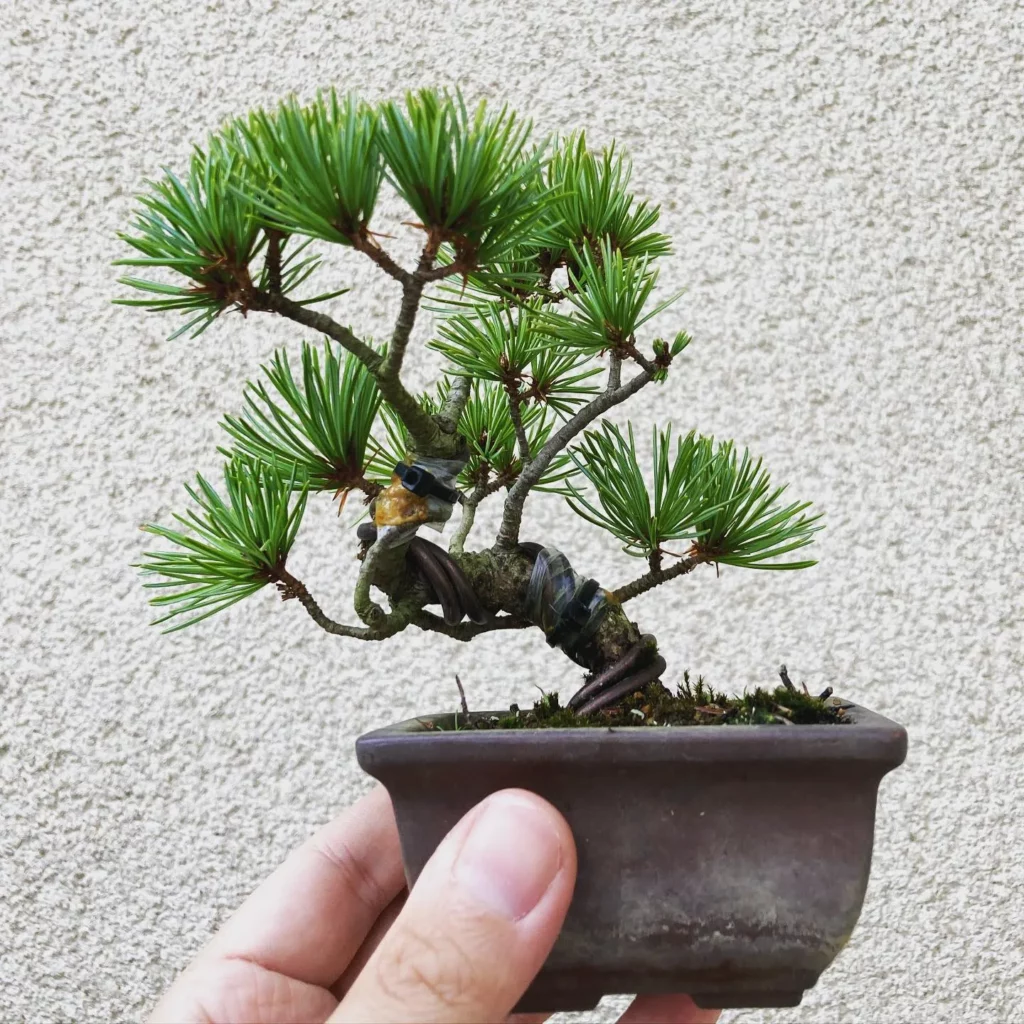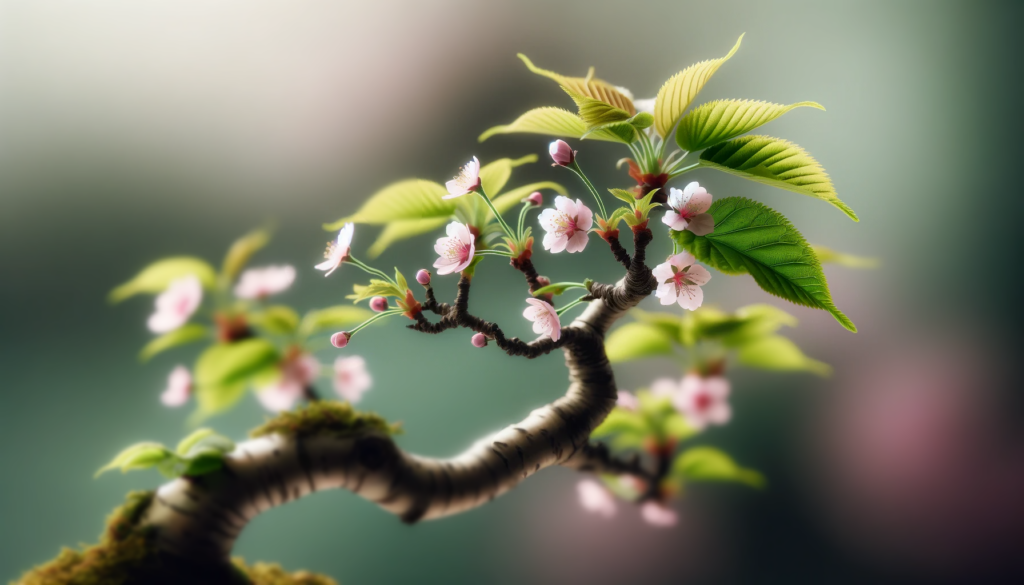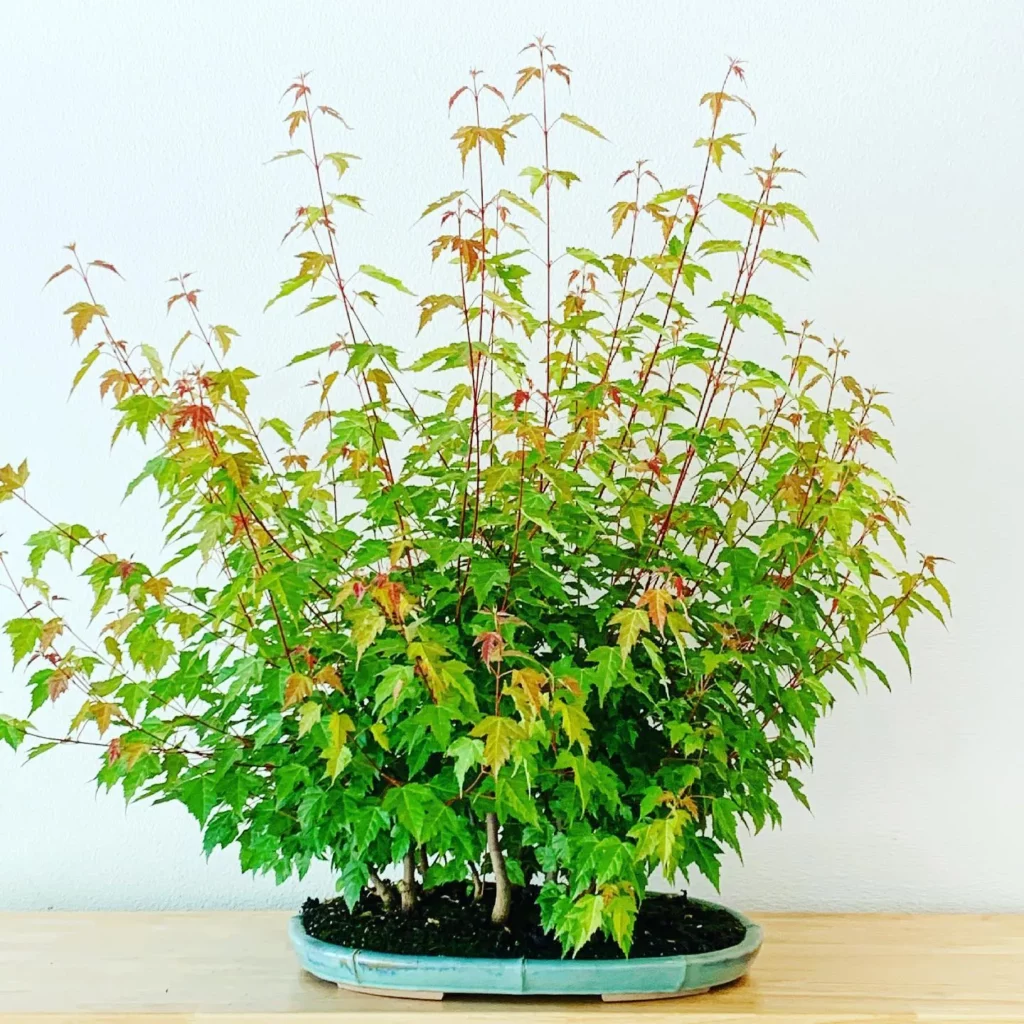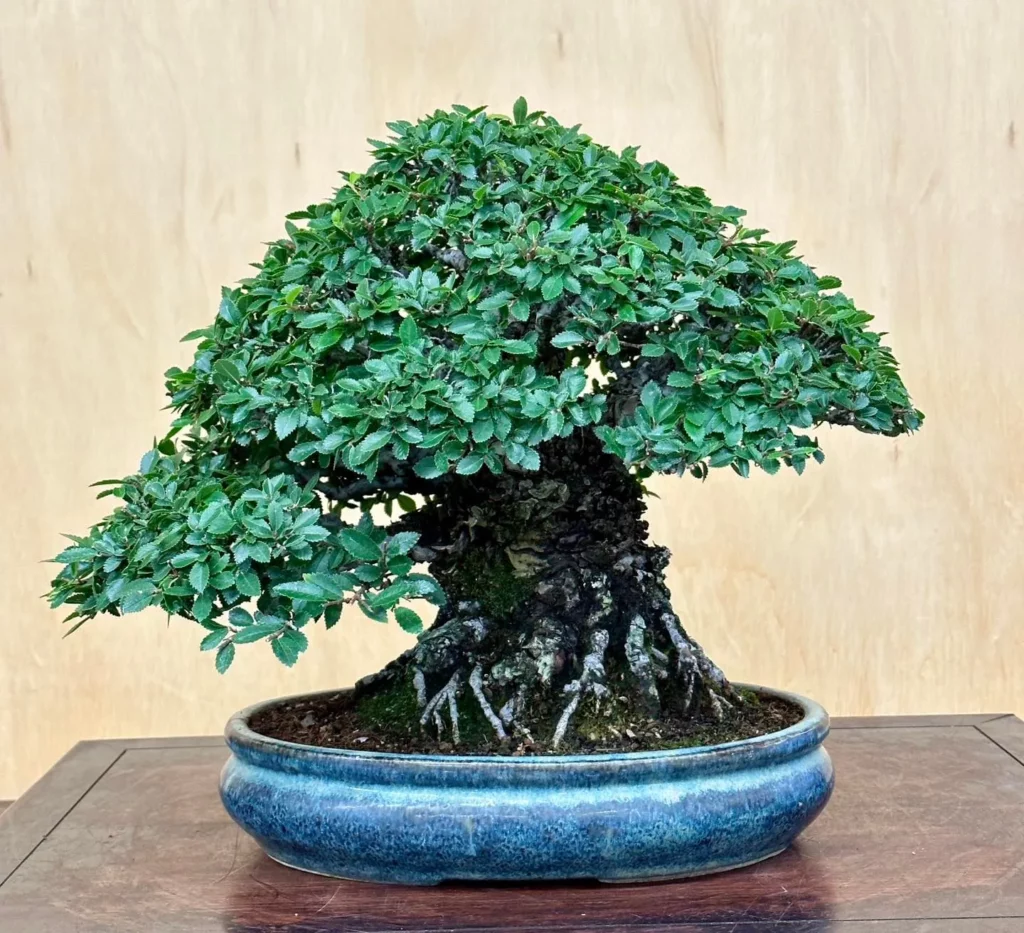Boxwood bonsai are known for their distinct appearance, characterized by small, rounded, and leathery leaves. These leaves give the bonsai a unique texture and a dense, compact look. The slow-growing nature of boxwood bonsai allows for intricate shaping and styling, making them a popular choice among bonsai enthusiasts.
Key Takeaways:
- Boxwood bonsai are slow-growing evergreen plants with small, rounded, and leathery leaves.
- Dwarf varieties are commonly used in landscaping.
- Boxwoods prefer well-drained soil, full sun to part-shade locations, and regular pruning.
- Water deeply every 2 to 4 weeks and fertilize in spring with an all-purpose fertilizer.
- Proper potting, propagation, and regular maintenance are essential for the growth and development of your Boxwood Bonsai.
Appearance of Boxwood Bonsai



There are several dwarf varieties of boxwood bonsai that showcase different characteristics. For example, Buxus sempervirens ‘Suffruticosa’ is a compact variety that grows to about 2-3 feet tall with a spread of 2-4 feet. Its tight foliage and rounded form create an elegant look. Another cultivar, Buxus microphylla japonica ‘Golden Triumph’, features variegated leaves and grows to a similar height and width, adding a touch of color to the bonsai display.
Light Requirements for Boxwood Bonsai



Proper lighting is essential for the health and growth of your boxwood bonsai. While these plants can tolerate full sun, they prefer some shade during the hottest part of the afternoon. Ideally, planting them in areas with dappled shade or in sheltered spots with cooler soil temperatures is beneficial. This will help prevent the leaves from burning or drying out in intense sunlight.
Boxwood bonsai are versatile and can adapt to different light conditions, but it’s important to monitor their needs, especially during hot summer weather. If you notice signs of stress such as wilting or yellowing leaves, it may indicate that your bonsai is receiving too much direct sunlight. In such cases, providing a bit more shade and ensuring the soil stays consistently moist can help alleviate the issue.
On the other hand, if your boxwood bonsai is not receiving enough sunlight, it may become leggy and have sparse foliage. Inadequate light can also make the plant more susceptible to diseases and pests. Therefore, it’s important to strike a balance and find the right amount of light for your boxwood bonsai to thrive.
Finding the Optimal Light Conditions:
- Observe your bonsai throughout the day to determine the amount of direct sunlight it receives.
- If your bonsai is in an area with intense afternoon sun, consider providing some afternoon shade to protect it from excessive heat.
- Monitor the soil moisture regularly and adjust your watering schedule accordingly. Boxwood bonsai in areas with more sunlight may require more frequent watering to prevent drying out.
- During very hot and dry periods, misting the foliage or placing the bonsai on a humidity tray can help maintain moisture levels.
Watering Boxwood Bonsai

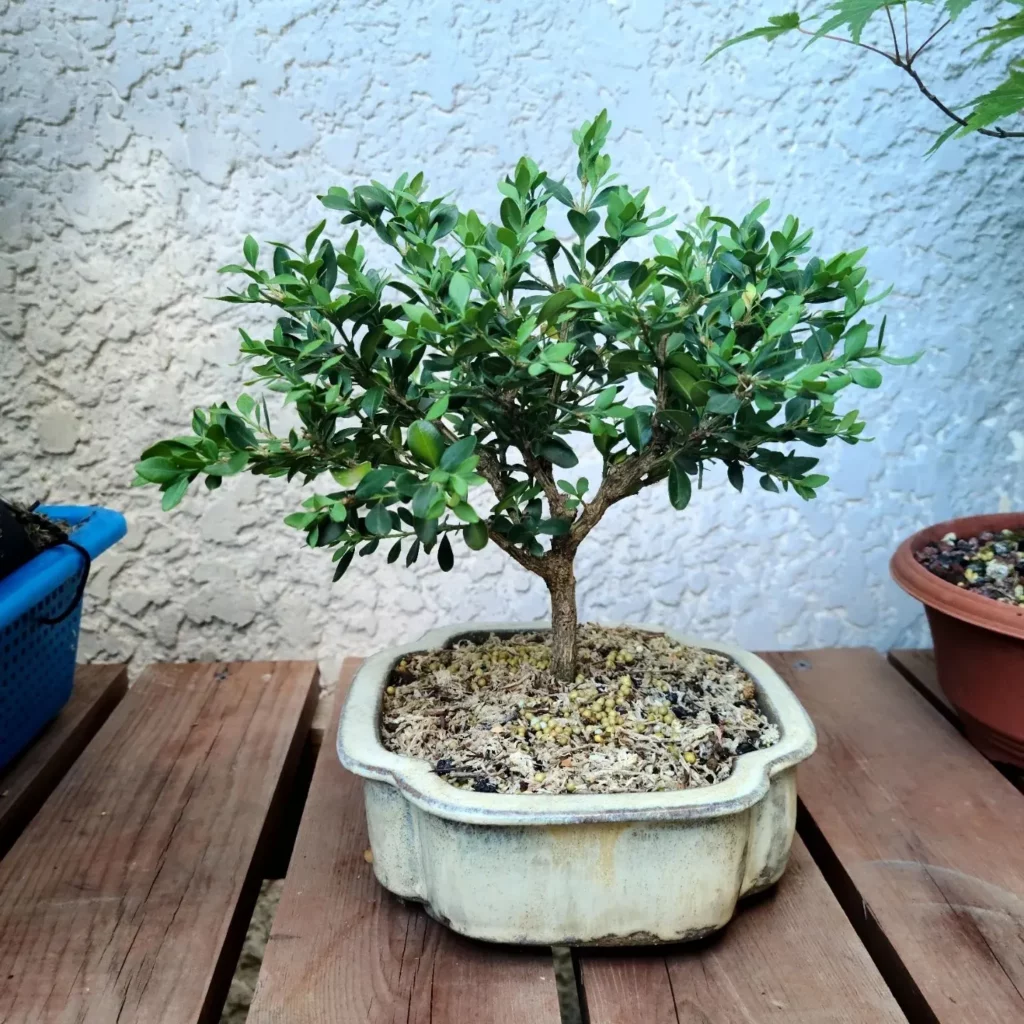

Proper watering is crucial for the health and vitality of your boxwood bonsai. Here are some essential tips to keep in mind:
- Deep weekly watering: During the first two years, it is important to water your boxwood bonsai deeply and thoroughly once a week. This encourages deep root development and helps the plant establish a strong foundation.
- Avoid shallow watering: Shallow watering does not reach the deepest roots of the bonsai. It is important to water until the soil is moist to a depth of at least one inch. This ensures that the entire root system receives adequate moisture.
- Monitor soil moisture: Regularly check the moisture level of the soil by sticking your finger or a moisture meter into the soil. Water when the top inch of soil feels dry. Avoid overwatering, as boxwood bonsai are susceptible to root rot.
- Deep watering frequency: Once the boxwood bonsai is established, deep watering every 2 to 4 weeks is usually sufficient. Adjust the frequency based on the weather conditions and the moisture needs of your specific bonsai.
- Consider the climate: In hot summer weather, boxwood bonsai may require more frequent watering. Monitor the moisture level of the soil closely during these periods and provide additional water as needed.
Signs of overwatering and underwatering
It is important to find the right balance with watering your boxwood bonsai. Here are some signs to watch for:
- Overwatering: If the leaves of your boxwood bonsai start turning yellow or the soil feels constantly wet, it may be a sign of overwatering. Adjust your watering schedule and allow the soil to dry out between waterings.
- Underwatering: If the leaves of your boxwood bonsai become dry, crispy, or start wilting, it may be a sign of underwatering. Increase the frequency of watering and ensure that the plant receives sufficient moisture.
Fertilizing Boxwood Bonsai
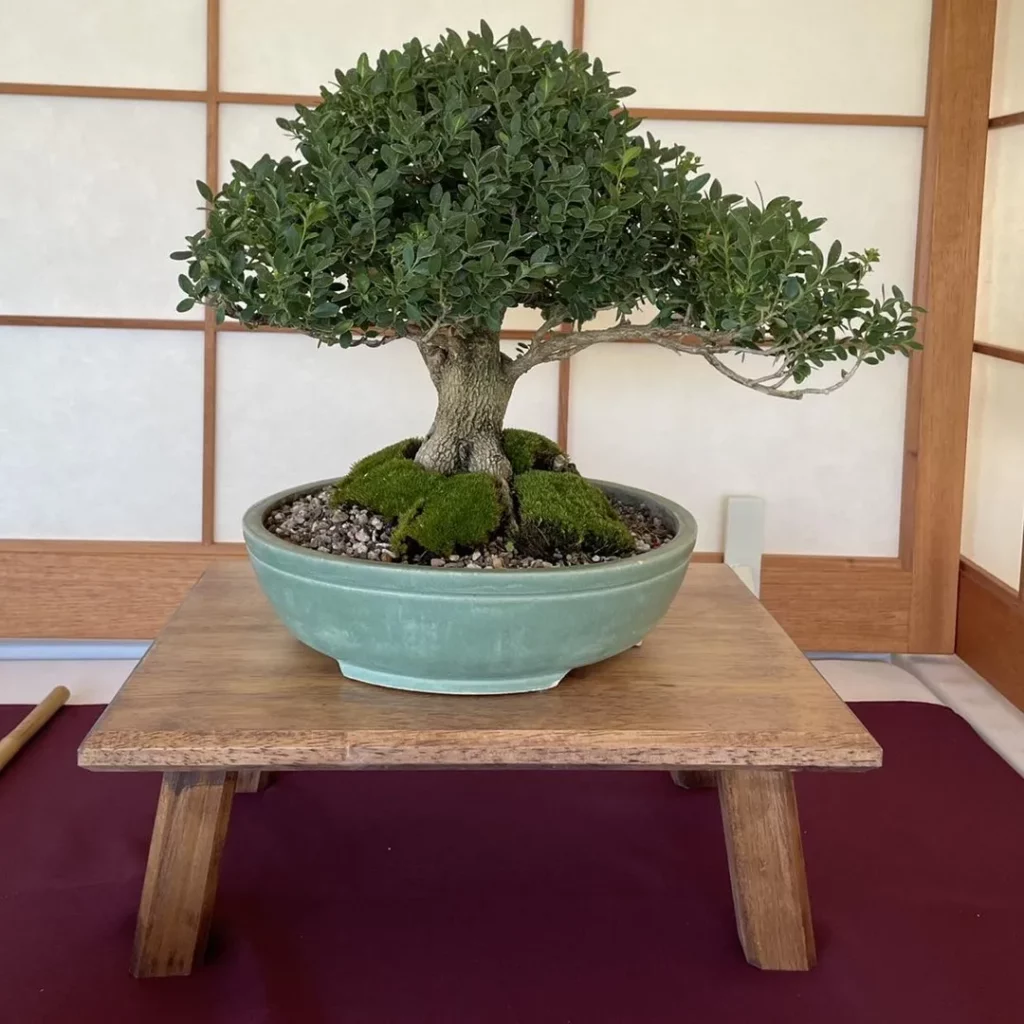

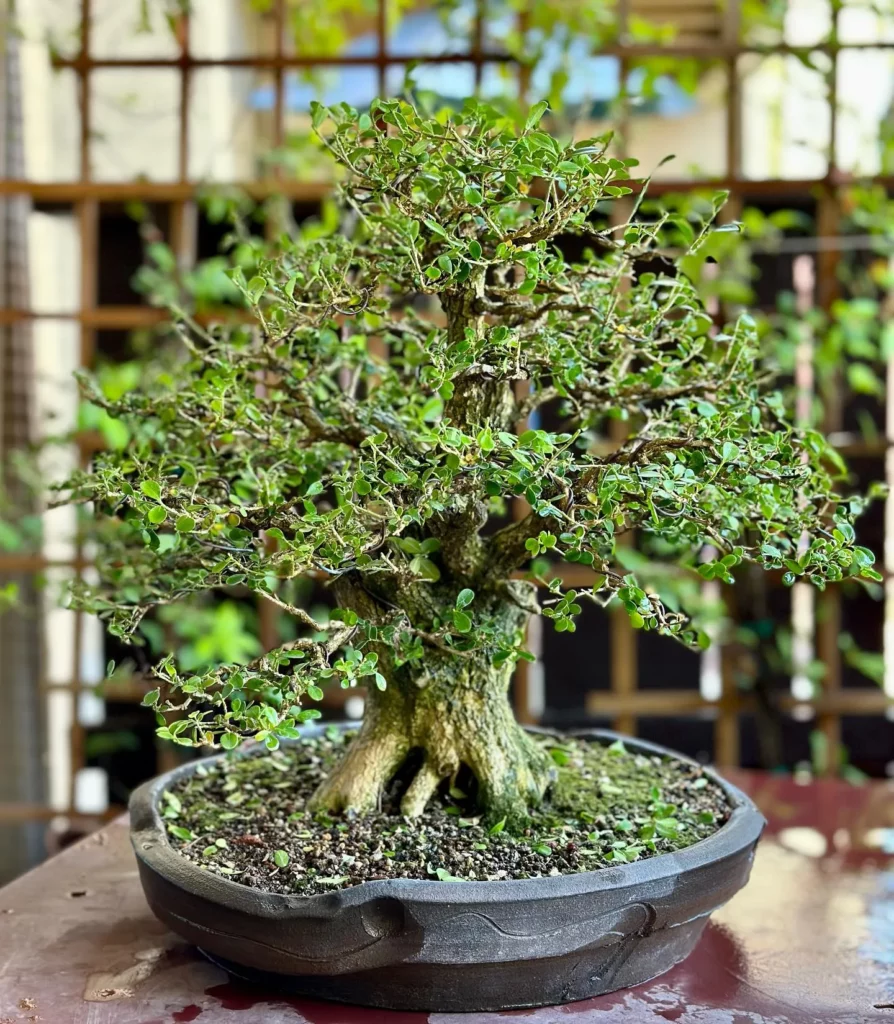
Fertilizing your boxwood bonsai is an essential part of its care routine. By providing the right nutrients, you can promote healthy growth and vibrant foliage. Here are some important tips to keep in mind when fertilizing your boxwood bonsai:
- Timing: Spring is the best time to fertilize your boxwood bonsai, right before the new growth emerges. This allows the plant to utilize the nutrients during its active growing season.
- Fertilizer selection: Choose an all-purpose fertilizer that is suitable for bonsai plants. Look for a balanced NPK ratio, such as 10-10-10 or 14-14-14, to provide a good mix of nitrogen, phosphorus, and potassium.
- Application: Follow the product label instructions for the correct amount of fertilizer to use. It’s important not to over-fertilize, as this can lead to salt buildup in the soil and damage the roots. Apply the fertilizer evenly around the base of the bonsai, avoiding direct contact with the trunk and foliage.
- Frequency: Fertilize your boxwood bonsai once every four to six weeks throughout the growing season. This regular feeding will ensure a steady supply of nutrients for optimum growth.
- Watering: After fertilizing, water your boxwood bonsai thoroughly to help distribute the nutrients evenly and prevent the roots from being burned by excessive fertilizer concentration.
Potting Boxwood Bonsai



Properly potting your boxwood bonsai is essential for its health and growth. Here are some tips on how to pot your boxwood bonsai:
- Choose the right container: Select a pot that is wide enough to accommodate the height of your bonsai. The pot should also have good drainage holes to prevent waterlogging.
- Ensure proper drainage: To improve drainage, add a layer of gravel or small stones at the bottom of the pot before adding the soil. This will help prevent water from sitting in the roots and causing root rot.
- Use well-draining soil: Use a well-draining bonsai soil mix or a combination of regular potting soil, perlite, and sand. Avoid using heavy clay-based soils as they retain too much moisture.
- Transplant when necessary: As your boxwood bonsai grows, it may outgrow its current pot. When this happens, carefully remove the bonsai from its current pot and transplant it into a slightly larger one. This will provide the roots with more room to grow.
Propagation of Boxwood Bonsai
If you’re interested in propagating your own boxwood bonsai, you’ll be pleased to know that it’s relatively simple to do. One common method is through stem cuttings. Start by taking 3-4 inch lengths of stem tips from new growth. Remove the lower leaves and scrape the bark from one side of the cutting. Plant the cuttings in a pot filled with a mixture of sand, peat moss, and vermiculite. Keep the pot in a sealed plastic bag in a bright location and mist the cutting when dry. Check for root development every few days, and once roots have formed, transplant the cutting into a container with a rich potting mix.
If you have the patience, growing boxwood bonsai from seeds is also possible. However, this method takes more time and effort. Start by collecting seeds from your mature boxwood bonsai. Soak the seeds in water for 24 hours and then sow them in a mixture of peat moss and sand. Keep the pot in a bright location and maintain consistent moisture levels. It may take several months for the seeds to germinate, so be patient. Once the seedlings have developed, you can transplant them into individual containers using a well-draining potting mix.
Propagation Tips:
- Take stem cuttings in early summer when the plant is actively growing.
- Choose healthy, disease-free stems for the best success.
- Provide consistent moisture and humidity to help with root development.
- Use a rooting hormone to encourage faster root growth.
Growth and Development of Boxwood Bonsai
Boxwood bonsai are renowned for their slow-growing nature, requiring regular maintenance to maintain their desired shape. The growth and development of these bonsai trees can be influenced through the art of pruning and shaping, allowing you to create a unique artistic expression.
Pruning is essential for removing dead branches or twisted growth, while also encouraging new growth and denser foliage. It is advisable to perform hard pruning for shape during the growing season, but it should be avoided in late fall to prevent winter bronzing, a shift in foliage color caused by winter exposure.
Boxwood bonsai can be grown as hedges or specimen plantings, depending on your landscaping needs. As hedges, they create a beautiful and formal boundary, while as specimen plantings, they serve as eye-catching focal points in your garden or outdoor space.
Maintaining the Aesthetics of Boxwood Bonsai
- Regular pruning and shaping to maintain desired form
- Removing dead branches or twisted growth
- Performing hard pruning during the growing season, avoiding late fall
Boxwood Bonsai as Versatile Landscaping Elements
- Hedges: Forming beautiful and formal boundaries
- Specimen Plantings: Eye-catching focal points in your garden
Pests and Diseases of Boxwood Bonsai
When caring for your boxwood bonsai, it’s important to be aware of the potential pests and diseases that can affect them. By taking proactive measures, you can help keep your bonsai healthy and thriving.
Pests:
Some common pests that can target boxwood bonsai include leafminer, boxwood mite, and boxwood psyllid. These pests can cause damage to the leaves and overall health of the plant. To combat them, you can use horticultural oils, which are effective in controlling these pests. Regularly inspect your bonsai for any signs of infestation and take action as soon as possible.
Diseases:
Boxwood bonsai are also susceptible to various diseases, such as fungal blights, leaf spot, and root rot. These diseases can be caused by factors like poorly drained soils and improper watering. To prevent them, ensure that your bonsai is planted in well-drained soil and watered appropriately. If any signs of disease appear, such as discolored or spotted leaves, take immediate steps to address the issue. Applying anti-desiccant sprays and providing proper care can help mitigate winter bronzing, a color shift in the foliage caused by winter exposure.
Regular monitoring of your boxwood bonsai is essential for early detection and management of pests and diseases. By staying vigilant and implementing appropriate measures, you can ensure the long-term health and beauty of your bonsai.
FAQ
How many species are there in the Buxus genus?
The Buxus genus includes about 70 species.
Are boxwoods toxic to pets?
Yes, boxwoods are toxic to dogs, cats, and horses.
What type of soil is best for planting boxwoods?
Boxwoods prefer loamy soil.
How often should boxwoods be watered?
Boxwoods require deep watering every 2 to 4 weeks.
When should boxwoods be fertilized?
Boxwoods should be fertilized in spring.
Can boxwood bonsai be grown in containers?
Yes, boxwood bonsai can be grown in containers.
How can boxwood bonsai be propagated?
Boxwood bonsai can be propagated through stem cuttings.
How often should boxwood bonsai be pruned?
Boxwood bonsai require regular pruning to maintain their shape.
What pests and diseases should I be aware of with boxwood bonsai?
Boxwood bonsai can be affected by pests such as leafminer, boxwood mite, and boxwood psyllid, as well as fungal blights and root rot.

